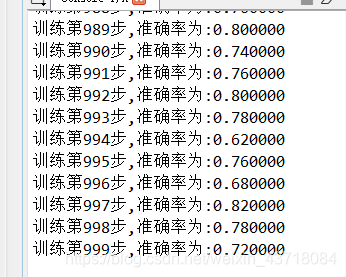八、(2)神经网络——卷积神经网络预测手写数字
第一步:设计两层卷积训练模型
# -*- coding: utf-8 -*-
"""
Created on Tue May 28 16:57:15 2019
@author: sun
"""
import tensorflow as tf
from tensorflow.examples.tutorials.mnist import input_data
#处理大数据可以导入下面模块
from tensorflow.contrib.slim.python.slim.nets.inception_v3 import inception_v3_base
# 定义一个初始化权重的函数
def weight_variables(shape):
w = tf.Variable(tf.random_normal(shape=shape, mean=0.0, stddev=1.0))
return w
# 定义一个初始化偏置的函数
def bias_variables(shape):
b = tf.Variable(tf.constant(0.0, shape=shape))
return b
def model():
"""
自定义的卷积模型
:return:
"""
# 1、准备数据的占位符 x [None, 784] y_true [None, 10]
with tf.variable_scope("data"):
x = tf.placeholder(tf.float32, [None, 784])
y_true = tf.placeholder(tf.int32, [None, 10])
# 2、一卷积层 卷积: 5*5*1,32个,strides=1 激活: tf.nn.relu 池化
with tf.variable_scope("conv1"):
# 随机初始化权重, 偏置[32]
w_conv1 = weight_variables([5, 5, 1, 32])
b_conv1 = bias_variables([32])
# 对x进行形状的改变[None, 784] [None, 28, 28, 1]
x_reshape = tf.reshape(x, [-1, 28, 28, 1])
# [None, 28, 28, 1]-----> [None, 28, 28, 32]
x_relu1 = tf.nn.relu(tf.nn.conv2d(x_reshape, w_conv1, strides=[1, 1, 1, 1], padding="SAME") + b_conv1)
# 池化 2*2 ,strides2 [None, 28, 28, 32]---->[None, 14, 14, 32]
x_pool1 = tf.nn.max_pool(x_relu1, ksize=[1, 2, 2, 1], strides=[1, 2, 2, 1], padding="SAME")
# 3、二卷积层卷积: 5*5*32,64个filter,strides=1 激活: tf.nn.relu 池化:
with tf.variable_scope("conv2"):
# 随机初始化权重, 权重:[5, 5, 32, 64] 偏置[64]
w_conv2 = weight_variables([5, 5, 32, 64])
b_conv2 = bias_variables([64])
# 卷积,激活,池化计算
# [None, 14, 14, 32]-----> [None, 14, 14, 64]
x_relu2 = tf.nn.relu(tf.nn.conv2d(x_pool1, w_conv2, strides=[1, 1, 1, 1], padding="SAME") + b_conv2)
# 池化 2*2, strides 2, [None, 14, 14, 64]---->[None, 7, 7, 64]
x_pool2 = tf.nn.max_pool(x_relu2, ksize=[1, 2, 2, 1], strides=[1, 2, 2, 1], padding="SAME")
# 4、全连接层 [None, 7, 7, 64]--->[None, 7*7*64]*[7*7*64, 10]+ [10] =[None, 10]
with tf.variable_scope("conv2"):
# 随机初始化权重和偏置
w_fc = weight_variables([7 * 7 * 64, 10])
b_fc = bias_variables([10])
# 修改形状 [None, 7, 7, 64] --->None, 7*7*64]
x_fc_reshape = tf.reshape(x_pool2, [-1, 7 * 7 * 64])
# 进行矩阵运算得出每个样本的10个结果
y_predict = tf.matmul(x_fc_reshape, w_fc) + b_fc
return x, y_true, y_predict
def conv_fc():
# 获取真实的数据
mnist = input_data.read_data_sets("./data/mnist/input_data/", one_hot=True)
# 定义模型,得出输出
x, y_true, y_predict = model()
# 进行交叉熵损失计算
# 3、求出所有样本的损失,然后求平均值
with tf.variable_scope("soft_cross"):
# 求平均交叉熵损失# 求平均交叉熵损失
loss = tf.reduce_mean(tf.nn.softmax_cross_entropy_with_logits(labels=y_true, logits=y_predict))
# 4、梯度下降求出损失
with tf.variable_scope("optimizer"):
train_op = tf.train.GradientDescentOptimizer(0.0001).minimize(loss)
# 5、计算准确率
with tf.variable_scope("acc"):
equal_list = tf.equal(tf.argmax(y_true, 1), tf.argmax(y_predict, 1))
# equal_list None个样本 [1, 0, 1, 0, 1, 1,..........]
accuracy = tf.reduce_mean(tf.cast(equal_list, tf.float32))
# 定义一个初始化变量的op
init_op = tf.global_variables_initializer()
# 创建一个saver
saver = tf.train.Saver()
# 开启回话运行
with tf.Session() as sess:
sess.run(init_op)
# 循环去训练
for i in range(1000):
# 取出真实存在的特征值和目标值
mnist_x, mnist_y = mnist.train.next_batch(50)
# 运行train_op训练
sess.run(train_op, feed_dict={x: mnist_x, y_true: mnist_y})
print("训练第%d步,准确率为:%f" % (i, sess.run(accuracy, feed_dict={x: mnist_x, y_true: mnist_y})))
# 保存模型
saver.save(sess, "./model2/cfc_model")
return None
if __name__ == "__main__":
conv_fc()
运行结果如图示(自己设置训练步数,步数太多适合GPU运行,CPU运行速度慢):

第二步:加载模型预测。代码参照八(1)中代码修改所得
# -*- coding: utf-8 -*-
"""
Created on Tue May 28 16:57:15 2019
@author: sun
"""
import tensorflow as tf
from tensorflow.examples.tutorials.mnist import input_data
#处理大数据可以导入下面模块
from tensorflow.contrib.slim.python.slim.nets.inception_v3 import inception_v3_base
#0为预测,1为测试。
FLAGS = tf.app.flags.FLAGS
tf.app.flags.DEFINE_integer("is_train", 0, "指定程序是预测还是训练")
# 定义一个初始化权重的函数
def weight_variables(shape):
w = tf.Variable(tf.random_normal(shape=shape, mean=0.0, stddev=1.0))
return w
# 定义一个初始化偏置的函数
def bias_variables(shape):
b = tf.Variable(tf.constant(0.0, shape=shape))
return b
def model():
"""
自定义的卷积模型
:return:
"""
# 1、准备数据的占位符 x [None, 784] y_true [None, 10]
with tf.variable_scope("data"):
x = tf.placeholder(tf.float32, [None, 784])
y_true = tf.placeholder(tf.int32, [None, 10])
# 2、一卷积层 卷积: 5*5*1,32个,strides=1 激活: tf.nn.relu 池化
with tf.variable_scope("conv1"):
# 随机初始化权重, 偏置[32]
w_conv1 = weight_variables([5, 5, 1, 32])
b_conv1 = bias_variables([32])
# 对x进行形状的改变[None, 784] [None, 28, 28, 1]
x_reshape = tf.reshape(x, [-1, 28, 28, 1])
# [None, 28, 28, 1]-----> [None, 28, 28, 32]
x_relu1 = tf.nn.relu(tf.nn.conv2d(x_reshape, w_conv1, strides=[1, 1, 1, 1], padding="SAME") + b_conv1)
# 池化 2*2 ,strides2 [None, 28, 28, 32]---->[None, 14, 14, 32]
x_pool1 = tf.nn.max_pool(x_relu1, ksize=[1, 2, 2, 1], strides=[1, 2, 2, 1], padding="SAME")
# 3、二卷积层卷积: 5*5*32,64个filter,strides=1 激活: tf.nn.relu 池化:
with tf.variable_scope("conv2"):
# 随机初始化权重, 权重:[5, 5, 32, 64] 偏置[64]
w_conv2 = weight_variables([5, 5, 32, 64])
b_conv2 = bias_variables([64])
# 卷积,激活,池化计算
# [None, 14, 14, 32]-----> [None, 14, 14, 64]
x_relu2 = tf.nn.relu(tf.nn.conv2d(x_pool1, w_conv2, strides=[1, 1, 1, 1], padding="SAME") + b_conv2)
# 池化 2*2, strides 2, [None, 14, 14, 64]---->[None, 7, 7, 64]
x_pool2 = tf.nn.max_pool(x_relu2, ksize=[1, 2, 2, 1], strides=[1, 2, 2, 1], padding="SAME")
# 4、全连接层 [None, 7, 7, 64]--->[None, 7*7*64]*[7*7*64, 10]+ [10] =[None, 10]
with tf.variable_scope("conv2"):
# 随机初始化权重和偏置
w_fc = weight_variables([7 * 7 * 64, 10])
b_fc = bias_variables([10])
# 修改形状 [None, 7, 7, 64] --->None, 7*7*64]
x_fc_reshape = tf.reshape(x_pool2, [-1, 7 * 7 * 64])
# 进行矩阵运算得出每个样本的10个结果
y_predict = tf.matmul(x_fc_reshape, w_fc) + b_fc
return x, y_true, y_predict
def conv_fc():
# 获取真实的数据
mnist = input_data.read_data_sets("./data/mnist/input_data/", one_hot=True)
# 定义模型,得出输出
x, y_true, y_predict = model()
# 进行交叉熵损失计算
# 3、求出所有样本的损失,然后求平均值
with tf.variable_scope("soft_cross"):
# 求平均交叉熵损失# 求平均交叉熵损失
loss = tf.reduce_mean(tf.nn.softmax_cross_entropy_with_logits(labels=y_true, logits=y_predict))
# 4、梯度下降求出损失
with tf.variable_scope("optimizer"):
train_op = tf.train.GradientDescentOptimizer(0.0001).minimize(loss)
# 5、计算准确率
with tf.variable_scope("acc"):
equal_list = tf.equal(tf.argmax(y_true, 1), tf.argmax(y_predict, 1))
# equal_list None个样本 [1, 0, 1, 0, 1, 1,..........]
accuracy = tf.reduce_mean(tf.cast(equal_list, tf.float32))
# 定义一个初始化变量的op
init_op = tf.global_variables_initializer()
# 创建一个saver
saver = tf.train.Saver()
# 开启回话运行
with tf.Session() as sess:
sess.run(init_op)
if FLAGS.is_train == 1:
# 循环去训练
for i in range(1000):
# 取出真实存在的特征值和目标值
mnist_x, mnist_y = mnist.train.next_batch(50)
# 运行train_op训练
sess.run(train_op, feed_dict={x: mnist_x, y_true: mnist_y})
print("训练第%d步,准确率为:%f" % (i, sess.run(accuracy, feed_dict={x: mnist_x, y_true: mnist_y})))
# 保存模型
saver.save(sess, "./model2/cfc_model")
else:
# 第一步中,设置为0则运行该部分代码,加载模型
saver.restore(sess, "./model2/cfc_model")
# 如果是0,做出预测
for i in range(100):
# 每次测试一张图片 [0,0,0,0,0,1,0,0,0,0]
x_test, y_test = mnist.test.next_batch(1)
print("第%d张图片,手写数字图片目标是:%d, 预测结果是:%d" % (
i,
tf.argmax(y_test, 1).eval(),
tf.argmax(sess.run(y_predict, feed_dict={x: x_test, y_true: y_test}), 1).eval()
))
print(accuracy)
return None
if __name__ == "__main__":
conv_fc()
运行结果如图示(正确率提高了):

搞定收工。
“☺☺☺ 若本篇文章对你有一丝丝帮助,请帮顶、评论点赞,谢谢。☺☺☺”
↓↓↓↓




 本文介绍了如何通过设计两层卷积神经网络模型来训练并预测手写数字,展示了训练过程和提高的准确率,最后成功完成任务。
本文介绍了如何通过设计两层卷积神经网络模型来训练并预测手写数字,展示了训练过程和提高的准确率,最后成功完成任务。
















 1万+
1万+

 被折叠的 条评论
为什么被折叠?
被折叠的 条评论
为什么被折叠?








